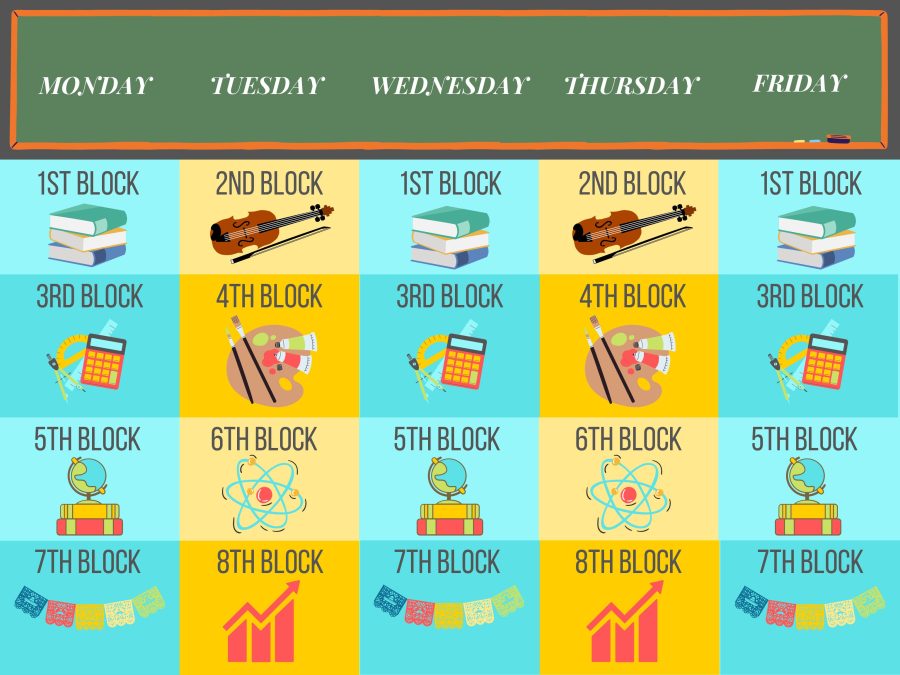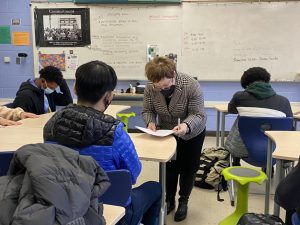Less is more: Why schools shouldn’t block out block scheduling
With block scheduling, 55 minute daily classes are replaced with longer class periods that meet fewer times per week. This scheduling system allows students to enroll in more classes and complete work at their own speed.
January 29, 2022
Block scheduling is a type of academic scheduling used in the K-12 system. Replacing the seven 55 minute daily periods with longer class periods that meet fewer times a week each day can improve student academic performance. Much effort has gone into the study of block scheduling and its extensive impact on student learning. There are both pros and cons to block scheduling Some of the major advantages noted are the following:
Improved teaching and learning with longer blocks, teachers have more time to complete lesson plans and to examine and re-evaluate practices. More class time is available to develop key concepts, incorporate creativity into instruction, and try a variety of classroom activities that address different learning styles. Longer time blocks allow for in depth study, such as individual student projects, peer collaboration, and one-on-one work between teachers and students.
Ability to focus attention the “less is more” philosophy espouses that students better understand and retain material when they have an opportunity to apply information to various contexts rather than merely cramming the facts with block scheduling, students and teachers are able to focus on fewer subjects, and to explore them in greater depth. Both teachers and students assert that this exploration allows them to become engrossed in the subject matter rather than moving rapidly through material. With a standard A and B block program, teachers have only three to four classes to teach in a given semester, greatly reducing the number of students with whom they meet regularly.
Fragment Reduced with block scheduling, instructional time is not fragmented by frequent transitions between classes. Fewer distinct classes means less time spent on classroom management activities, such as calling attendance and organizing and focusing the class. In addition, there are fewer opportunities for students to arrive late to class.
Individualized pacing the A and B block schedule allows advanced students to move through material at a more rapid rate, and they are able to finish sequential language classes, such as Spanish I and II, within one academic year. Some schools allow students to use this to their advantage and graduate early. The A and B block schedule also provides the opportunity for failing students to retake a class without falling behind their grade level.
More course offerings because students actually take more courses in the standard A and B plan because they enroll in at least 8 classes per year instead of six or seven.
Stronger interpersonal relationships, the number of daily classes for which students and teachers must adjust and prepare is decreased, allowing students to develop the deeper interpersonal relationships that are integral to academic success Teachers get to know students more personally which enables them to adapt lessons to the interests of their students. This extensive personal interaction between teacher and student, frequently touted as the highest motivation for student learning, is strengthened through block scheduling.
Achievement levels increase, students’ grades improve overall. There are fewer failed classes, a higher number of students on the honor roll, an increase in students’ grade point averages, and fewer failing marks. Statistics reveal that fewer at-risk students drop out of a school with block scheduling.
Attitudes and comprehension improves. Students state that they get more done in class and learn more because they are better able to focus their attention on their studies. Teachers appreciate the inclusion of projects and activities that facilitate both learning and interpersonal communication. Classes address material in more depth, and teachers feel students are better able to comprehend and retain concepts learned in a block period.
Pace of the school relaxes by longer passing periods between classes can slow down the pace of a school by providing the chance for students to get books from the library, use the restroom, and talk with their friends.
With the block schedule I think that it can improve our school tremendously by having students get more work done in the day and create stronger relationships. Our school could be just like Washtenaw International High School (WIHI). The system they have there is very organized and they learn so much everyday. What would make our school better is that we have so many more courses and opportunities which would make our school one of the best in Michigan.















